Implement and Maintain Internal Control Procedures Assessment Workbook
VerifiedAdded on 2020/04/21
|47
|8273
|93
Homework Assignment
AI Summary
This assessment workbook, designed for the FNSACC506 unit, focuses on implementing and maintaining internal control procedures. It covers key concepts in corporate governance, including the roles of government bodies like the Australian Securities and Investments Commission (ASIC), the Australian Securities Exchange (ASX), and the Australian Competition and Consumer Commission (ACCC). The workbook explores corporation law principles, the differences between public and private companies, and the application of replaceable rules and constitutions in internal management. The assessment includes both generic questions to test foundational knowledge and workplace-related scenarios, aiming to evaluate the student's ability to apply theoretical concepts to practical situations. The workbook also includes detailed answers to the questions regarding legislation, regulatory authorities, and the principles of corporation law, providing a comprehensive overview of the subject matter.
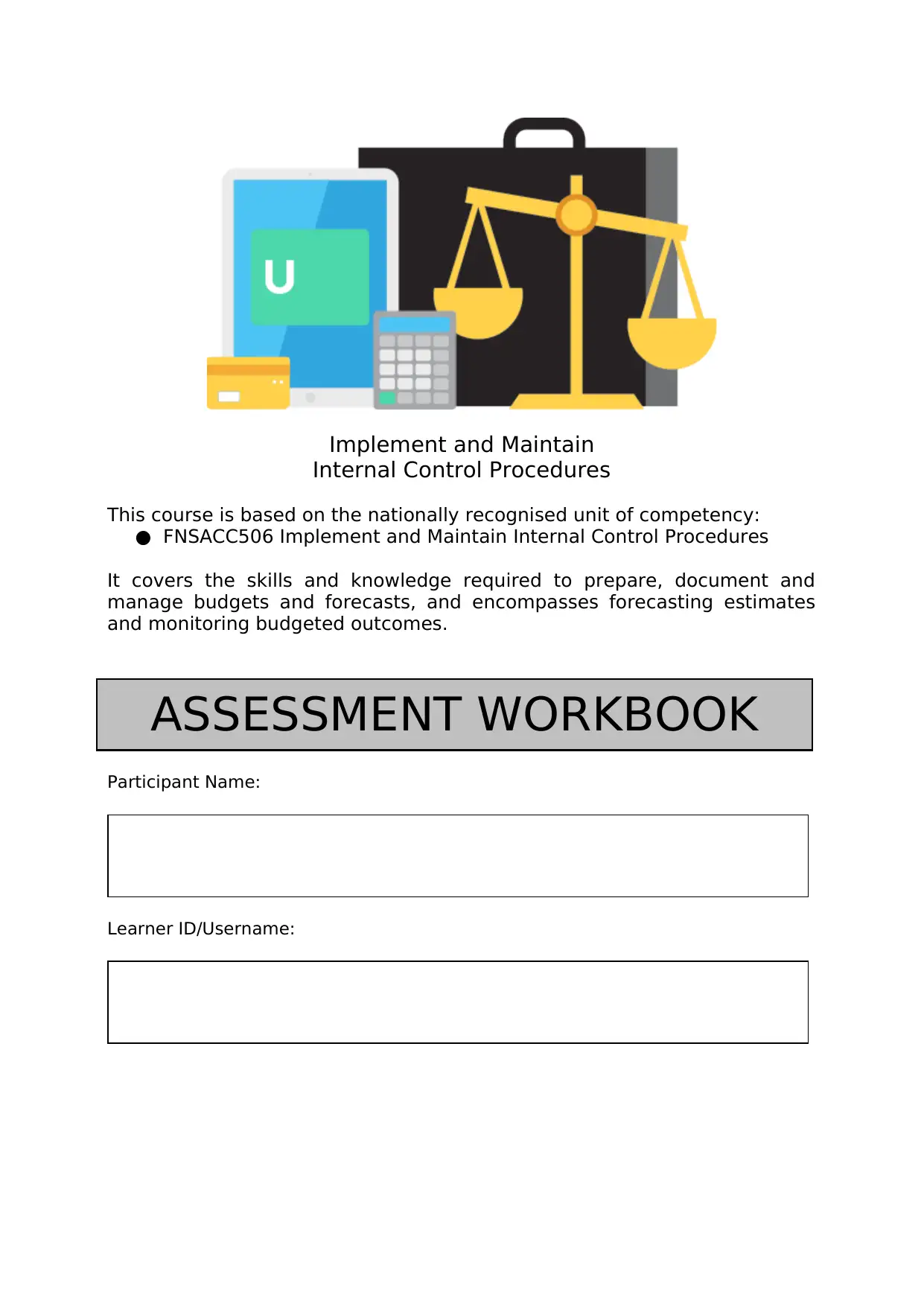
Implement and Maintain
Internal Control Procedures
This course is based on the nationally recognised unit of competency:
● FNSACC506 Implement and Maintain Internal Control Procedures
It covers the skills and knowledge required to prepare, document and
manage budgets and forecasts, and encompasses forecasting estimates
and monitoring budgeted outcomes.
ASSESSMENT WORKBOOK
Participant Name:
Learner ID/Username:
Internal Control Procedures
This course is based on the nationally recognised unit of competency:
● FNSACC506 Implement and Maintain Internal Control Procedures
It covers the skills and knowledge required to prepare, document and
manage budgets and forecasts, and encompasses forecasting estimates
and monitoring budgeted outcomes.
ASSESSMENT WORKBOOK
Participant Name:
Learner ID/Username:
Paraphrase This Document
Need a fresh take? Get an instant paraphrase of this document with our AI Paraphraser
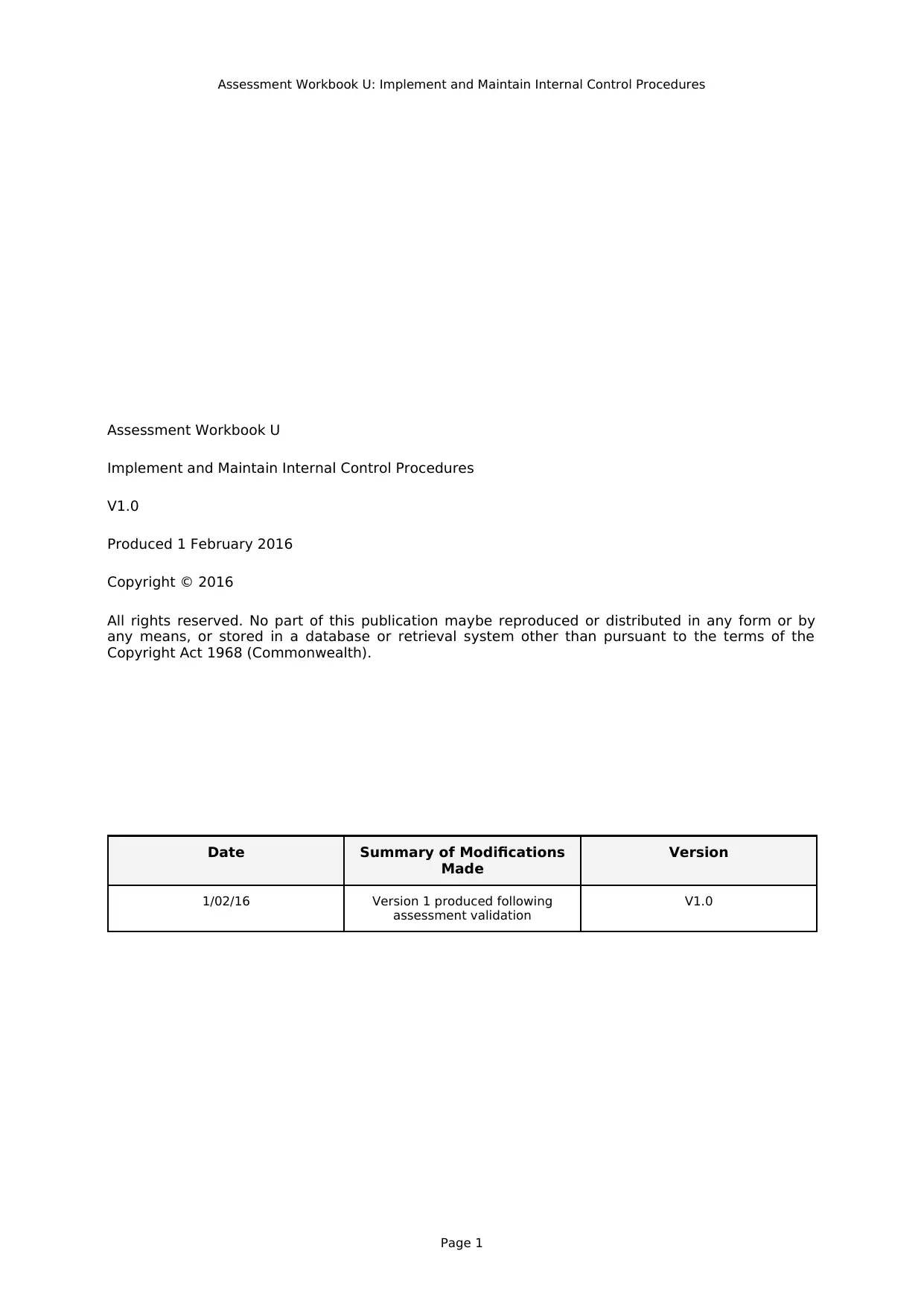
Assessment Workbook U: Implement and Maintain Internal Control Procedures
Assessment Workbook U
Implement and Maintain Internal Control Procedures
V1.0
Produced 1 February 2016
Copyright © 2016
All rights reserved. No part of this publication maybe reproduced or distributed in any form or by
any means, or stored in a database or retrieval system other than pursuant to the terms of the
Copyright Act 1968 (Commonwealth).
Date Summary of Modifications
Made
Version
1/02/16 Version 1 produced following
assessment validation
V1.0
Page 1
Assessment Workbook U
Implement and Maintain Internal Control Procedures
V1.0
Produced 1 February 2016
Copyright © 2016
All rights reserved. No part of this publication maybe reproduced or distributed in any form or by
any means, or stored in a database or retrieval system other than pursuant to the terms of the
Copyright Act 1968 (Commonwealth).
Date Summary of Modifications
Made
Version
1/02/16 Version 1 produced following
assessment validation
V1.0
Page 1

Assessment Workbook U: Implement and Maintain Internal Control Procedures
Page 2
Page 2
⊘ This is a preview!⊘
Do you want full access?
Subscribe today to unlock all pages.

Trusted by 1+ million students worldwide
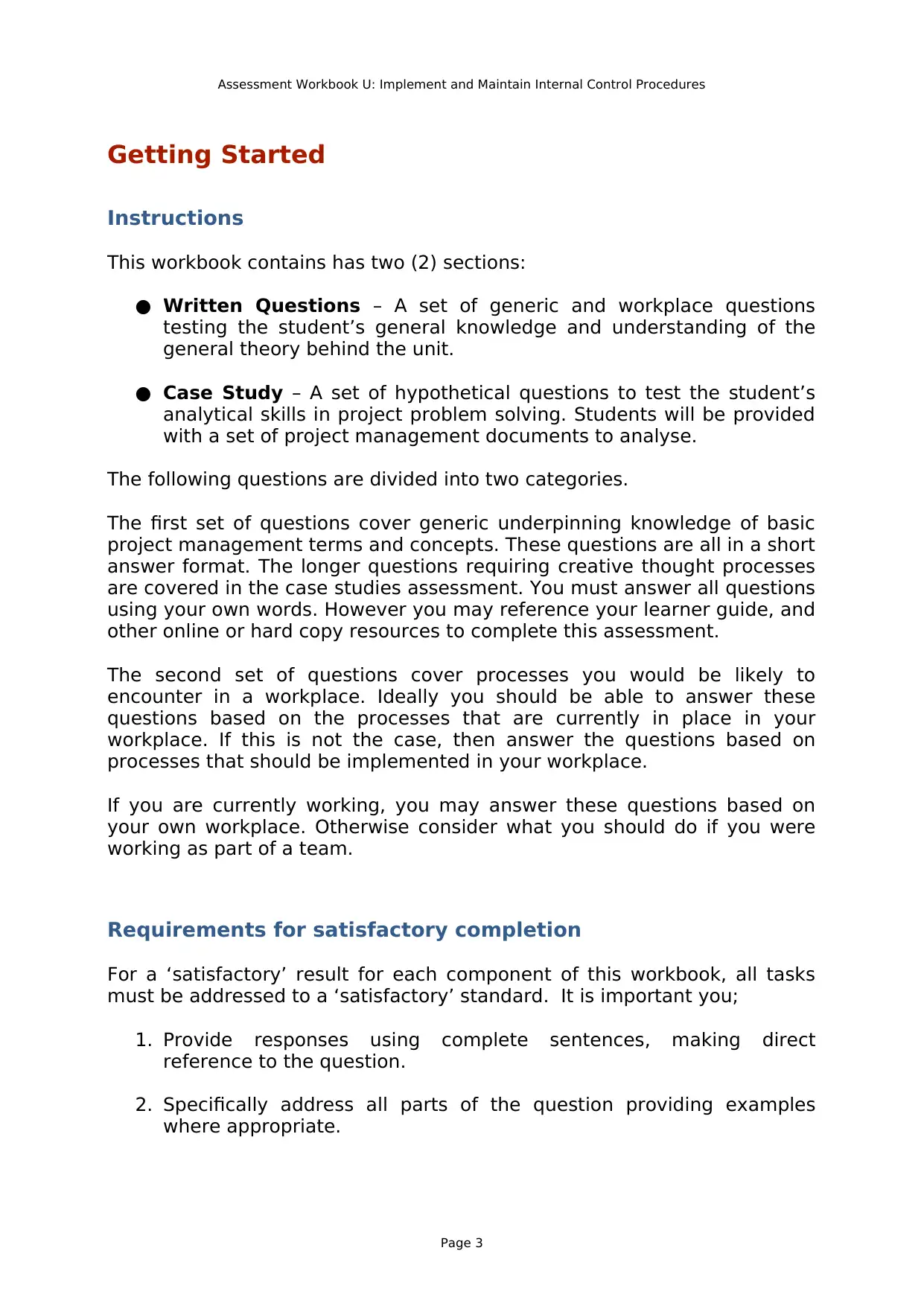
Assessment Workbook U: Implement and Maintain Internal Control Procedures
Getting Started
Instructions
This workbook contains has two (2) sections:
● Written Questions – A set of generic and workplace questions
testing the student’s general knowledge and understanding of the
general theory behind the unit.
● Case Study – A set of hypothetical questions to test the student’s
analytical skills in project problem solving. Students will be provided
with a set of project management documents to analyse.
The following questions are divided into two categories.
The first set of questions cover generic underpinning knowledge of basic
project management terms and concepts. These questions are all in a short
answer format. The longer questions requiring creative thought processes
are covered in the case studies assessment. You must answer all questions
using your own words. However you may reference your learner guide, and
other online or hard copy resources to complete this assessment.
The second set of questions cover processes you would be likely to
encounter in a workplace. Ideally you should be able to answer these
questions based on the processes that are currently in place in your
workplace. If this is not the case, then answer the questions based on
processes that should be implemented in your workplace.
If you are currently working, you may answer these questions based on
your own workplace. Otherwise consider what you should do if you were
working as part of a team.
Requirements for satisfactory completion
For a ‘satisfactory’ result for each component of this workbook, all tasks
must be addressed to a ‘satisfactory’ standard. It is important you;
1. Provide responses using complete sentences, making direct
reference to the question.
2. Specifically address all parts of the question providing examples
where appropriate.
Page 3
Getting Started
Instructions
This workbook contains has two (2) sections:
● Written Questions – A set of generic and workplace questions
testing the student’s general knowledge and understanding of the
general theory behind the unit.
● Case Study – A set of hypothetical questions to test the student’s
analytical skills in project problem solving. Students will be provided
with a set of project management documents to analyse.
The following questions are divided into two categories.
The first set of questions cover generic underpinning knowledge of basic
project management terms and concepts. These questions are all in a short
answer format. The longer questions requiring creative thought processes
are covered in the case studies assessment. You must answer all questions
using your own words. However you may reference your learner guide, and
other online or hard copy resources to complete this assessment.
The second set of questions cover processes you would be likely to
encounter in a workplace. Ideally you should be able to answer these
questions based on the processes that are currently in place in your
workplace. If this is not the case, then answer the questions based on
processes that should be implemented in your workplace.
If you are currently working, you may answer these questions based on
your own workplace. Otherwise consider what you should do if you were
working as part of a team.
Requirements for satisfactory completion
For a ‘satisfactory’ result for each component of this workbook, all tasks
must be addressed to a ‘satisfactory’ standard. It is important you;
1. Provide responses using complete sentences, making direct
reference to the question.
2. Specifically address all parts of the question providing examples
where appropriate.
Page 3
Paraphrase This Document
Need a fresh take? Get an instant paraphrase of this document with our AI Paraphraser
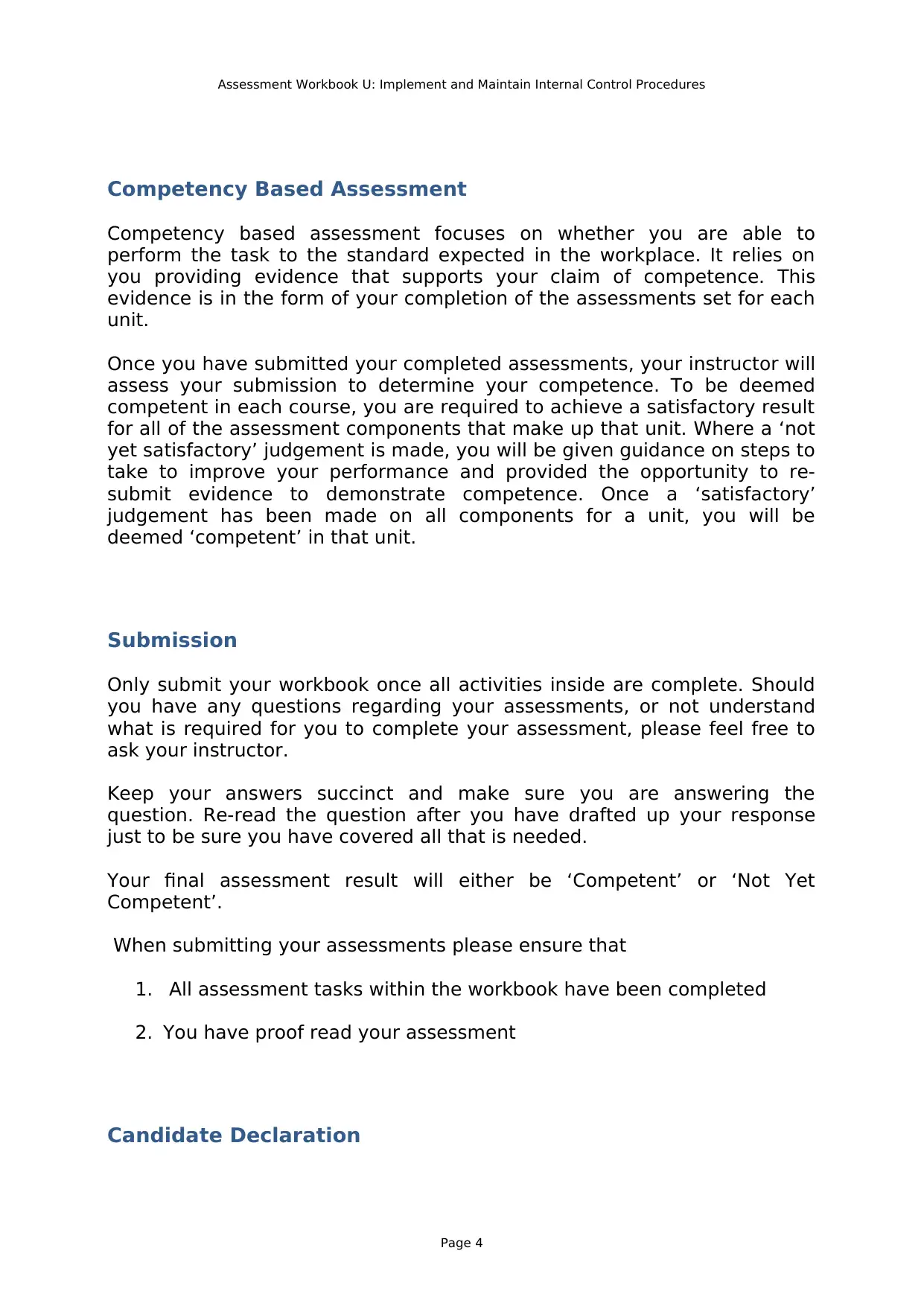
Assessment Workbook U: Implement and Maintain Internal Control Procedures
Competency Based Assessment
Competency based assessment focuses on whether you are able to
perform the task to the standard expected in the workplace. It relies on
you providing evidence that supports your claim of competence. This
evidence is in the form of your completion of the assessments set for each
unit.
Once you have submitted your completed assessments, your instructor will
assess your submission to determine your competence. To be deemed
competent in each course, you are required to achieve a satisfactory result
for all of the assessment components that make up that unit. Where a ‘not
yet satisfactory’ judgement is made, you will be given guidance on steps to
take to improve your performance and provided the opportunity to re-
submit evidence to demonstrate competence. Once a ‘satisfactory’
judgement has been made on all components for a unit, you will be
deemed ‘competent’ in that unit.
Submission
Only submit your workbook once all activities inside are complete. Should
you have any questions regarding your assessments, or not understand
what is required for you to complete your assessment, please feel free to
ask your instructor.
Keep your answers succinct and make sure you are answering the
question. Re-read the question after you have drafted up your response
just to be sure you have covered all that is needed.
Your final assessment result will either be ‘Competent’ or ‘Not Yet
Competent’.
When submitting your assessments please ensure that
1. All assessment tasks within the workbook have been completed
2. You have proof read your assessment
Candidate Declaration
Page 4
Competency Based Assessment
Competency based assessment focuses on whether you are able to
perform the task to the standard expected in the workplace. It relies on
you providing evidence that supports your claim of competence. This
evidence is in the form of your completion of the assessments set for each
unit.
Once you have submitted your completed assessments, your instructor will
assess your submission to determine your competence. To be deemed
competent in each course, you are required to achieve a satisfactory result
for all of the assessment components that make up that unit. Where a ‘not
yet satisfactory’ judgement is made, you will be given guidance on steps to
take to improve your performance and provided the opportunity to re-
submit evidence to demonstrate competence. Once a ‘satisfactory’
judgement has been made on all components for a unit, you will be
deemed ‘competent’ in that unit.
Submission
Only submit your workbook once all activities inside are complete. Should
you have any questions regarding your assessments, or not understand
what is required for you to complete your assessment, please feel free to
ask your instructor.
Keep your answers succinct and make sure you are answering the
question. Re-read the question after you have drafted up your response
just to be sure you have covered all that is needed.
Your final assessment result will either be ‘Competent’ or ‘Not Yet
Competent’.
When submitting your assessments please ensure that
1. All assessment tasks within the workbook have been completed
2. You have proof read your assessment
Candidate Declaration
Page 4
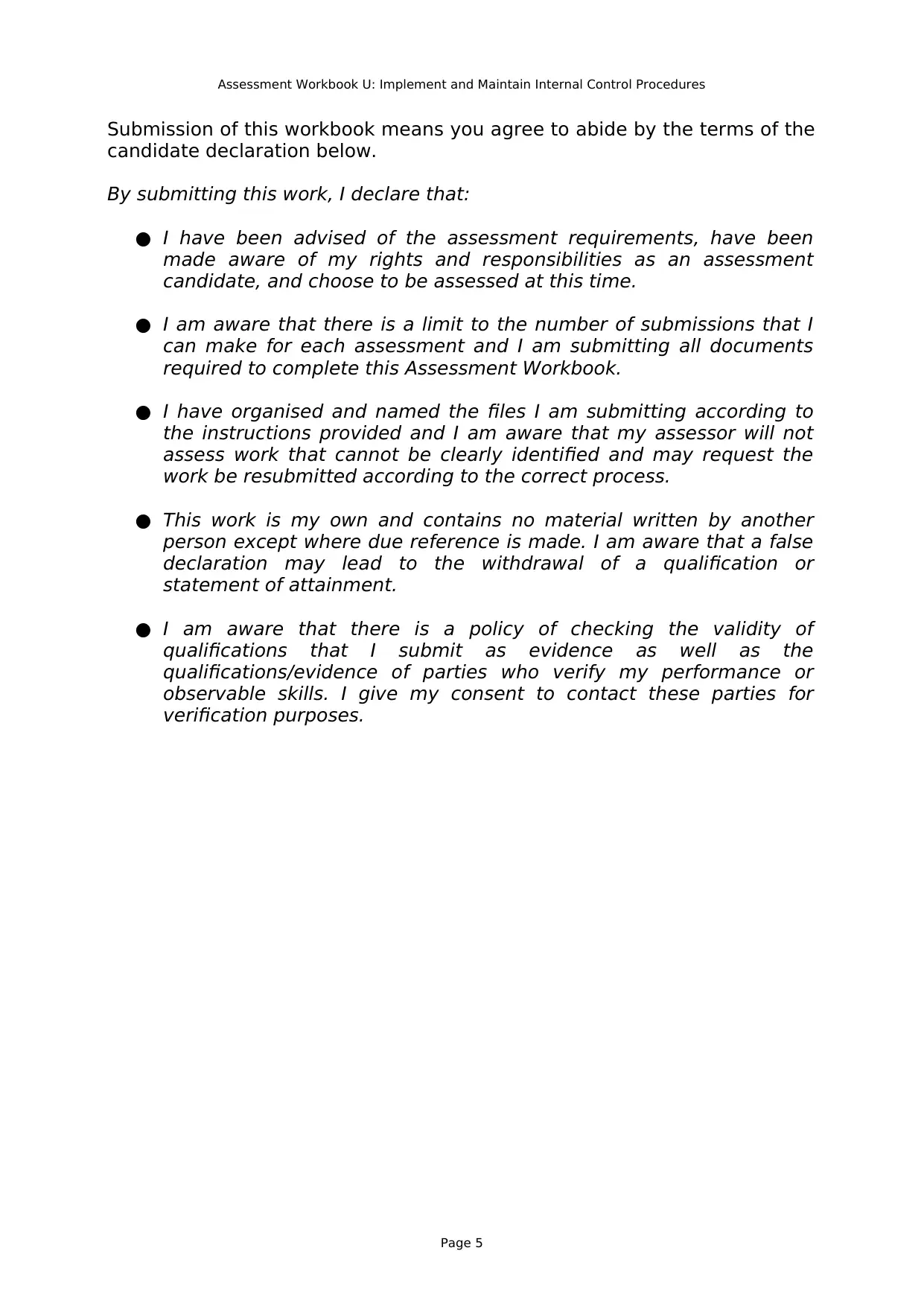
Assessment Workbook U: Implement and Maintain Internal Control Procedures
Submission of this workbook means you agree to abide by the terms of the
candidate declaration below.
By submitting this work, I declare that:
● I have been advised of the assessment requirements, have been
made aware of my rights and responsibilities as an assessment
candidate, and choose to be assessed at this time.
● I am aware that there is a limit to the number of submissions that I
can make for each assessment and I am submitting all documents
required to complete this Assessment Workbook.
● I have organised and named the files I am submitting according to
the instructions provided and I am aware that my assessor will not
assess work that cannot be clearly identified and may request the
work be resubmitted according to the correct process.
● This work is my own and contains no material written by another
person except where due reference is made. I am aware that a false
declaration may lead to the withdrawal of a qualification or
statement of attainment.
● I am aware that there is a policy of checking the validity of
qualifications that I submit as evidence as well as the
qualifications/evidence of parties who verify my performance or
observable skills. I give my consent to contact these parties for
verification purposes.
Page 5
Submission of this workbook means you agree to abide by the terms of the
candidate declaration below.
By submitting this work, I declare that:
● I have been advised of the assessment requirements, have been
made aware of my rights and responsibilities as an assessment
candidate, and choose to be assessed at this time.
● I am aware that there is a limit to the number of submissions that I
can make for each assessment and I am submitting all documents
required to complete this Assessment Workbook.
● I have organised and named the files I am submitting according to
the instructions provided and I am aware that my assessor will not
assess work that cannot be clearly identified and may request the
work be resubmitted according to the correct process.
● This work is my own and contains no material written by another
person except where due reference is made. I am aware that a false
declaration may lead to the withdrawal of a qualification or
statement of attainment.
● I am aware that there is a policy of checking the validity of
qualifications that I submit as evidence as well as the
qualifications/evidence of parties who verify my performance or
observable skills. I give my consent to contact these parties for
verification purposes.
Page 5
⊘ This is a preview!⊘
Do you want full access?
Subscribe today to unlock all pages.

Trusted by 1+ million students worldwide
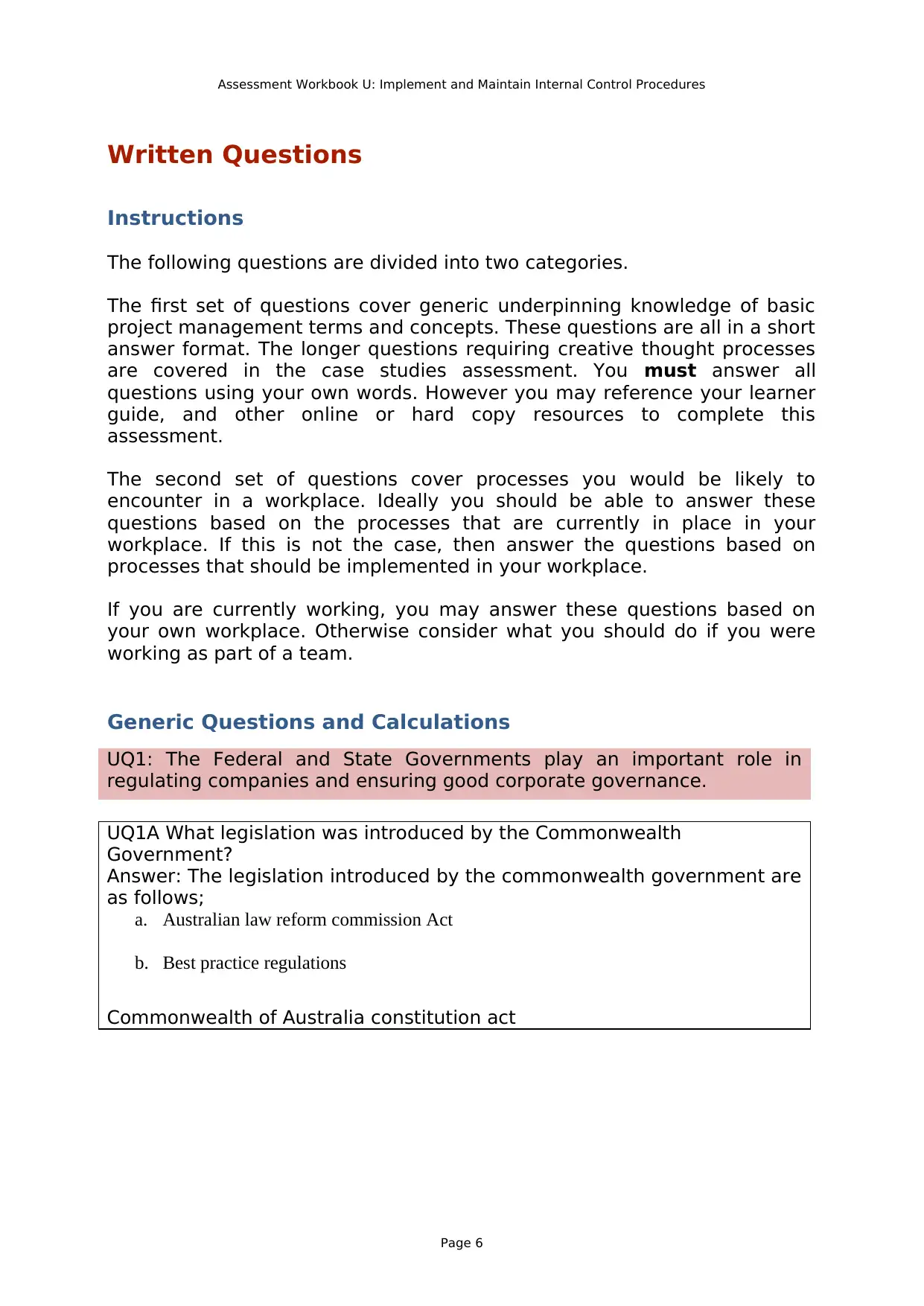
Assessment Workbook U: Implement and Maintain Internal Control Procedures
Written Questions
Instructions
The following questions are divided into two categories.
The first set of questions cover generic underpinning knowledge of basic
project management terms and concepts. These questions are all in a short
answer format. The longer questions requiring creative thought processes
are covered in the case studies assessment. You must answer all
questions using your own words. However you may reference your learner
guide, and other online or hard copy resources to complete this
assessment.
The second set of questions cover processes you would be likely to
encounter in a workplace. Ideally you should be able to answer these
questions based on the processes that are currently in place in your
workplace. If this is not the case, then answer the questions based on
processes that should be implemented in your workplace.
If you are currently working, you may answer these questions based on
your own workplace. Otherwise consider what you should do if you were
working as part of a team.
Generic Questions and Calculations
UQ1: The Federal and State Governments play an important role in
regulating companies and ensuring good corporate governance.
UQ1A What legislation was introduced by the Commonwealth
Government?
Answer: The legislation introduced by the commonwealth government are
as follows;
a. Australian law reform commission Act
b. Best practice regulations
Commonwealth of Australia constitution act
Page 6
Written Questions
Instructions
The following questions are divided into two categories.
The first set of questions cover generic underpinning knowledge of basic
project management terms and concepts. These questions are all in a short
answer format. The longer questions requiring creative thought processes
are covered in the case studies assessment. You must answer all
questions using your own words. However you may reference your learner
guide, and other online or hard copy resources to complete this
assessment.
The second set of questions cover processes you would be likely to
encounter in a workplace. Ideally you should be able to answer these
questions based on the processes that are currently in place in your
workplace. If this is not the case, then answer the questions based on
processes that should be implemented in your workplace.
If you are currently working, you may answer these questions based on
your own workplace. Otherwise consider what you should do if you were
working as part of a team.
Generic Questions and Calculations
UQ1: The Federal and State Governments play an important role in
regulating companies and ensuring good corporate governance.
UQ1A What legislation was introduced by the Commonwealth
Government?
Answer: The legislation introduced by the commonwealth government are
as follows;
a. Australian law reform commission Act
b. Best practice regulations
Commonwealth of Australia constitution act
Page 6
Paraphrase This Document
Need a fresh take? Get an instant paraphrase of this document with our AI Paraphraser
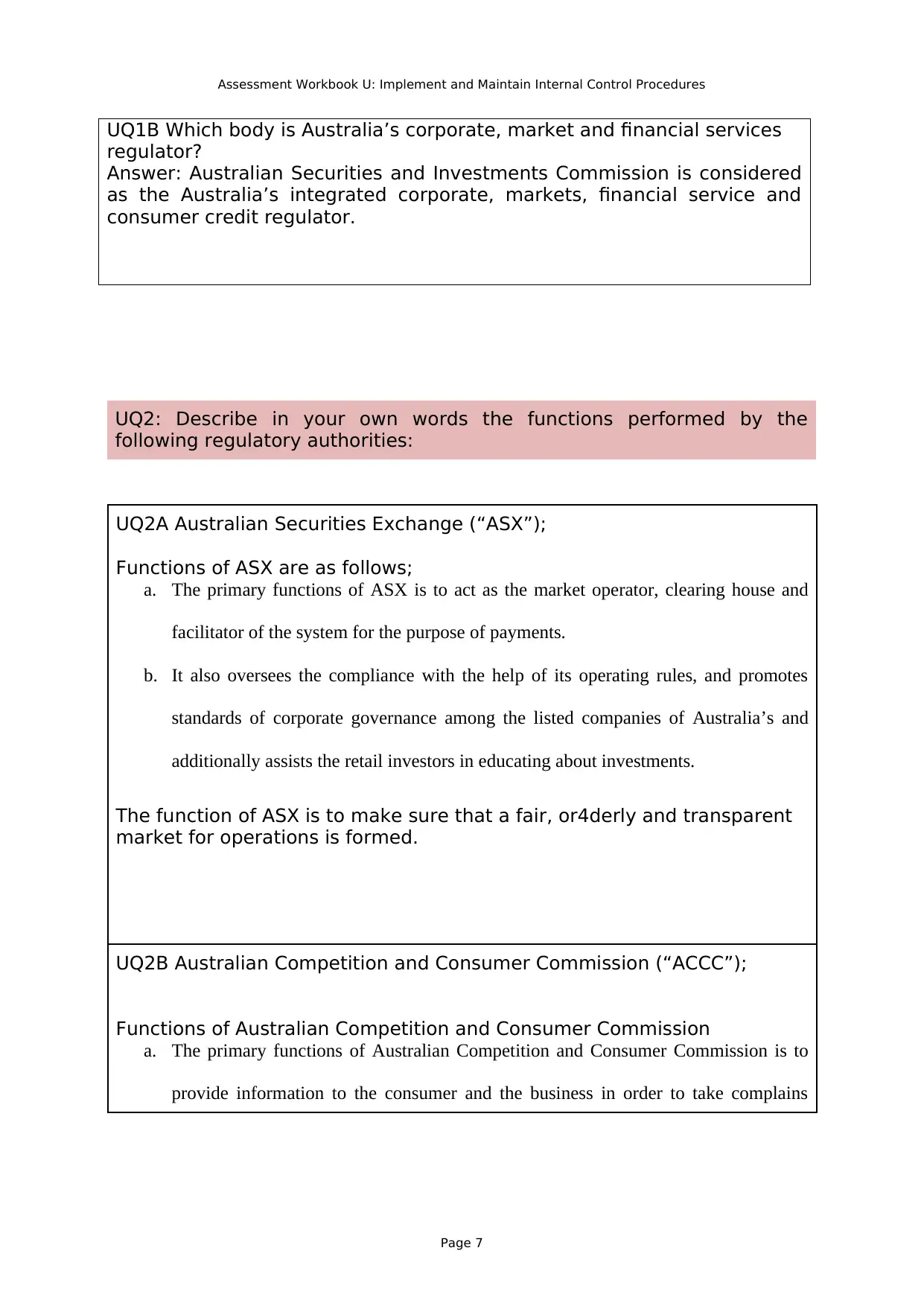
Assessment Workbook U: Implement and Maintain Internal Control Procedures
UQ1B Which body is Australia’s corporate, market and financial services
regulator?
Answer: Australian Securities and Investments Commission is considered
as the Australia’s integrated corporate, markets, financial service and
consumer credit regulator.
UQ2: Describe in your own words the functions performed by the
following regulatory authorities:
UQ2A Australian Securities Exchange (“ASX”);
Functions of ASX are as follows;
a. The primary functions of ASX is to act as the market operator, clearing house and
facilitator of the system for the purpose of payments.
b. It also oversees the compliance with the help of its operating rules, and promotes
standards of corporate governance among the listed companies of Australia’s and
additionally assists the retail investors in educating about investments.
The function of ASX is to make sure that a fair, or4derly and transparent
market for operations is formed.
UQ2B Australian Competition and Consumer Commission (“ACCC”);
Functions of Australian Competition and Consumer Commission
a. The primary functions of Australian Competition and Consumer Commission is to
provide information to the consumer and the business in order to take complains
Page 7
UQ1B Which body is Australia’s corporate, market and financial services
regulator?
Answer: Australian Securities and Investments Commission is considered
as the Australia’s integrated corporate, markets, financial service and
consumer credit regulator.
UQ2: Describe in your own words the functions performed by the
following regulatory authorities:
UQ2A Australian Securities Exchange (“ASX”);
Functions of ASX are as follows;
a. The primary functions of ASX is to act as the market operator, clearing house and
facilitator of the system for the purpose of payments.
b. It also oversees the compliance with the help of its operating rules, and promotes
standards of corporate governance among the listed companies of Australia’s and
additionally assists the retail investors in educating about investments.
The function of ASX is to make sure that a fair, or4derly and transparent
market for operations is formed.
UQ2B Australian Competition and Consumer Commission (“ACCC”);
Functions of Australian Competition and Consumer Commission
a. The primary functions of Australian Competition and Consumer Commission is to
provide information to the consumer and the business in order to take complains
Page 7
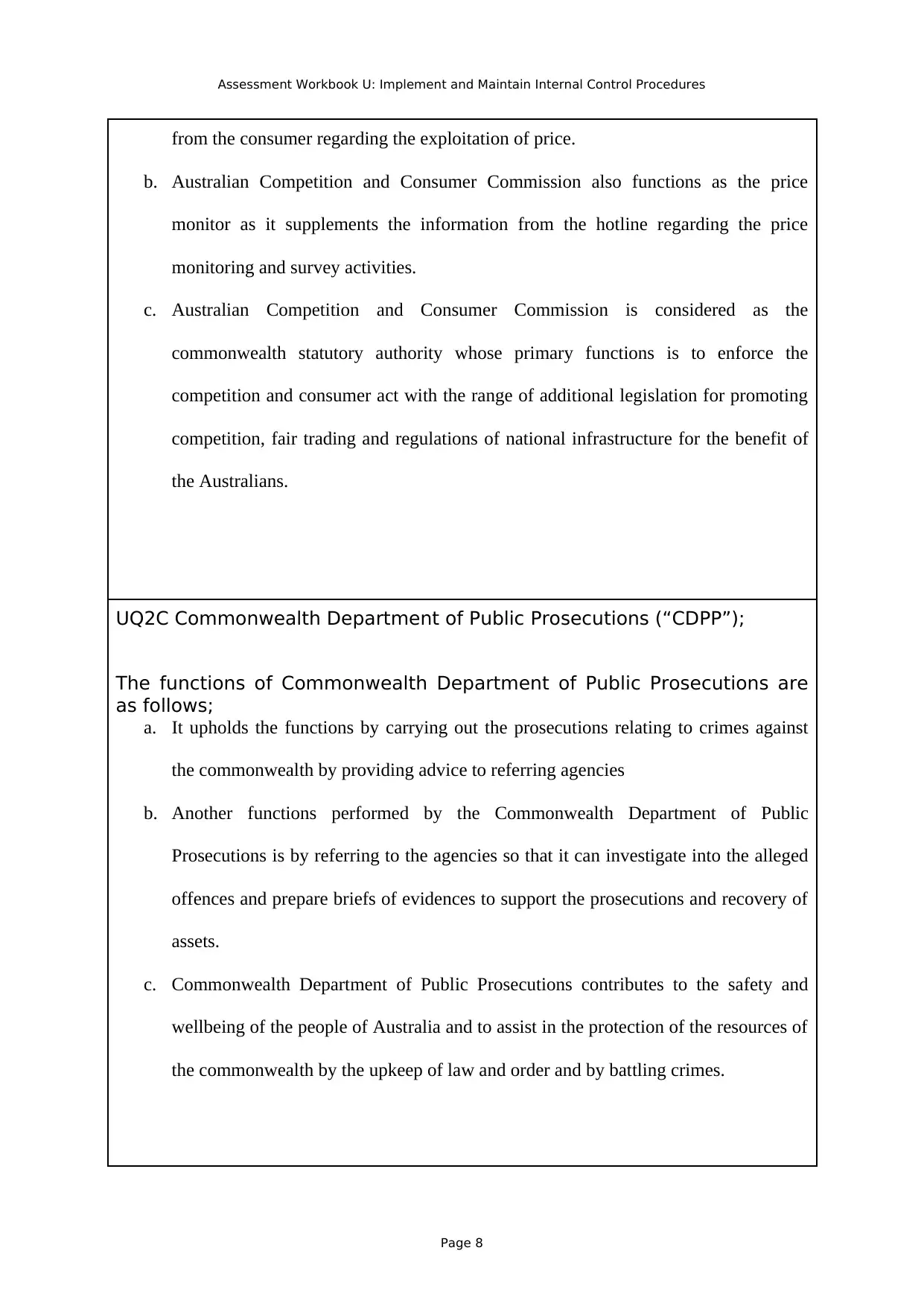
Assessment Workbook U: Implement and Maintain Internal Control Procedures
from the consumer regarding the exploitation of price.
b. Australian Competition and Consumer Commission also functions as the price
monitor as it supplements the information from the hotline regarding the price
monitoring and survey activities.
c. Australian Competition and Consumer Commission is considered as the
commonwealth statutory authority whose primary functions is to enforce the
competition and consumer act with the range of additional legislation for promoting
competition, fair trading and regulations of national infrastructure for the benefit of
the Australians.
UQ2C Commonwealth Department of Public Prosecutions (“CDPP”);
The functions of Commonwealth Department of Public Prosecutions are
as follows;
a. It upholds the functions by carrying out the prosecutions relating to crimes against
the commonwealth by providing advice to referring agencies
b. Another functions performed by the Commonwealth Department of Public
Prosecutions is by referring to the agencies so that it can investigate into the alleged
offences and prepare briefs of evidences to support the prosecutions and recovery of
assets.
c. Commonwealth Department of Public Prosecutions contributes to the safety and
wellbeing of the people of Australia and to assist in the protection of the resources of
the commonwealth by the upkeep of law and order and by battling crimes.
Page 8
from the consumer regarding the exploitation of price.
b. Australian Competition and Consumer Commission also functions as the price
monitor as it supplements the information from the hotline regarding the price
monitoring and survey activities.
c. Australian Competition and Consumer Commission is considered as the
commonwealth statutory authority whose primary functions is to enforce the
competition and consumer act with the range of additional legislation for promoting
competition, fair trading and regulations of national infrastructure for the benefit of
the Australians.
UQ2C Commonwealth Department of Public Prosecutions (“CDPP”);
The functions of Commonwealth Department of Public Prosecutions are
as follows;
a. It upholds the functions by carrying out the prosecutions relating to crimes against
the commonwealth by providing advice to referring agencies
b. Another functions performed by the Commonwealth Department of Public
Prosecutions is by referring to the agencies so that it can investigate into the alleged
offences and prepare briefs of evidences to support the prosecutions and recovery of
assets.
c. Commonwealth Department of Public Prosecutions contributes to the safety and
wellbeing of the people of Australia and to assist in the protection of the resources of
the commonwealth by the upkeep of law and order and by battling crimes.
Page 8
⊘ This is a preview!⊘
Do you want full access?
Subscribe today to unlock all pages.

Trusted by 1+ million students worldwide
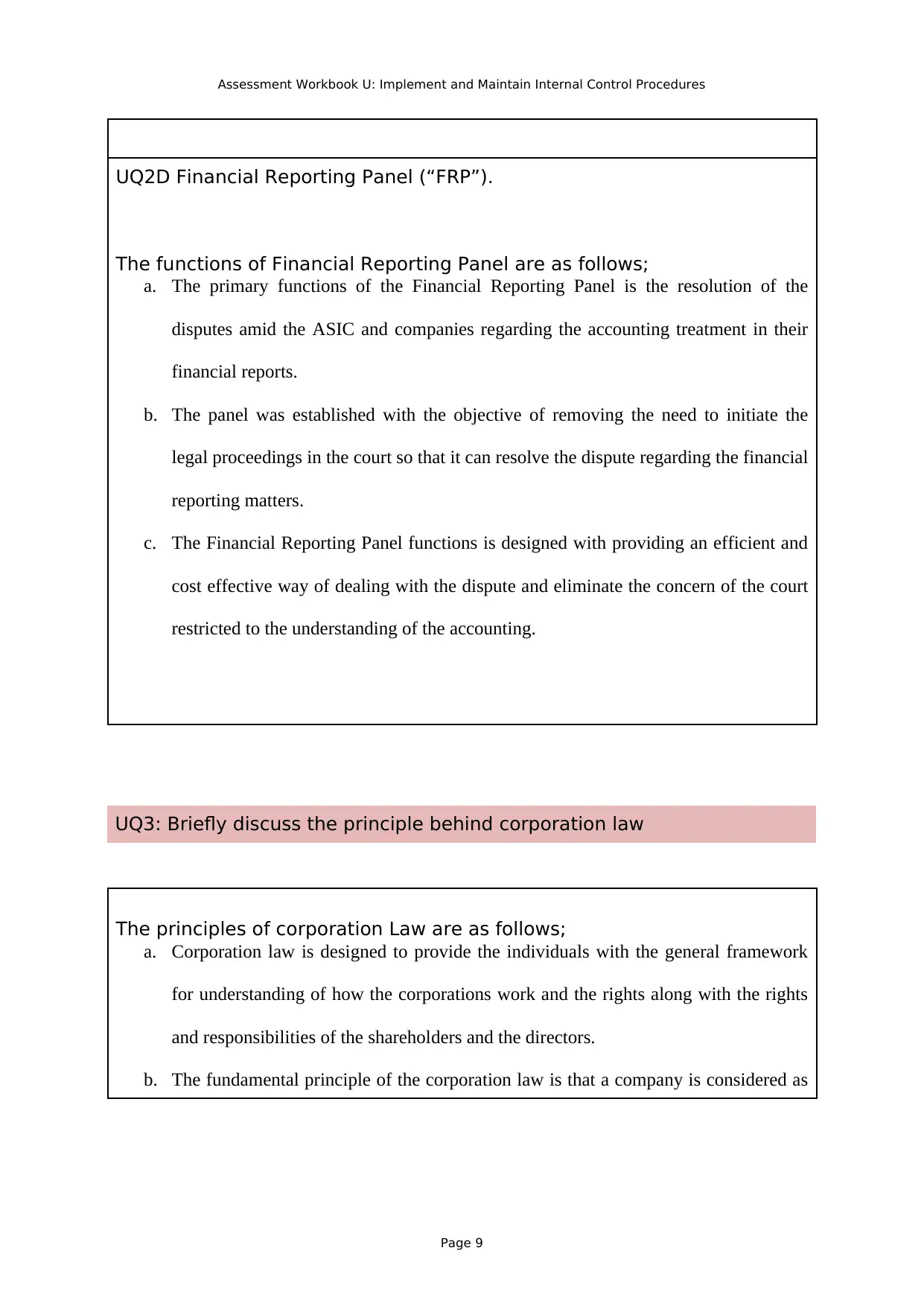
Assessment Workbook U: Implement and Maintain Internal Control Procedures
UQ2D Financial Reporting Panel (“FRP”).
The functions of Financial Reporting Panel are as follows;
a. The primary functions of the Financial Reporting Panel is the resolution of the
disputes amid the ASIC and companies regarding the accounting treatment in their
financial reports.
b. The panel was established with the objective of removing the need to initiate the
legal proceedings in the court so that it can resolve the dispute regarding the financial
reporting matters.
c. The Financial Reporting Panel functions is designed with providing an efficient and
cost effective way of dealing with the dispute and eliminate the concern of the court
restricted to the understanding of the accounting.
UQ3: Briefly discuss the principle behind corporation law
The principles of corporation Law are as follows;
a. Corporation law is designed to provide the individuals with the general framework
for understanding of how the corporations work and the rights along with the rights
and responsibilities of the shareholders and the directors.
b. The fundamental principle of the corporation law is that a company is considered as
Page 9
UQ2D Financial Reporting Panel (“FRP”).
The functions of Financial Reporting Panel are as follows;
a. The primary functions of the Financial Reporting Panel is the resolution of the
disputes amid the ASIC and companies regarding the accounting treatment in their
financial reports.
b. The panel was established with the objective of removing the need to initiate the
legal proceedings in the court so that it can resolve the dispute regarding the financial
reporting matters.
c. The Financial Reporting Panel functions is designed with providing an efficient and
cost effective way of dealing with the dispute and eliminate the concern of the court
restricted to the understanding of the accounting.
UQ3: Briefly discuss the principle behind corporation law
The principles of corporation Law are as follows;
a. Corporation law is designed to provide the individuals with the general framework
for understanding of how the corporations work and the rights along with the rights
and responsibilities of the shareholders and the directors.
b. The fundamental principle of the corporation law is that a company is considered as
Page 9
Paraphrase This Document
Need a fresh take? Get an instant paraphrase of this document with our AI Paraphraser
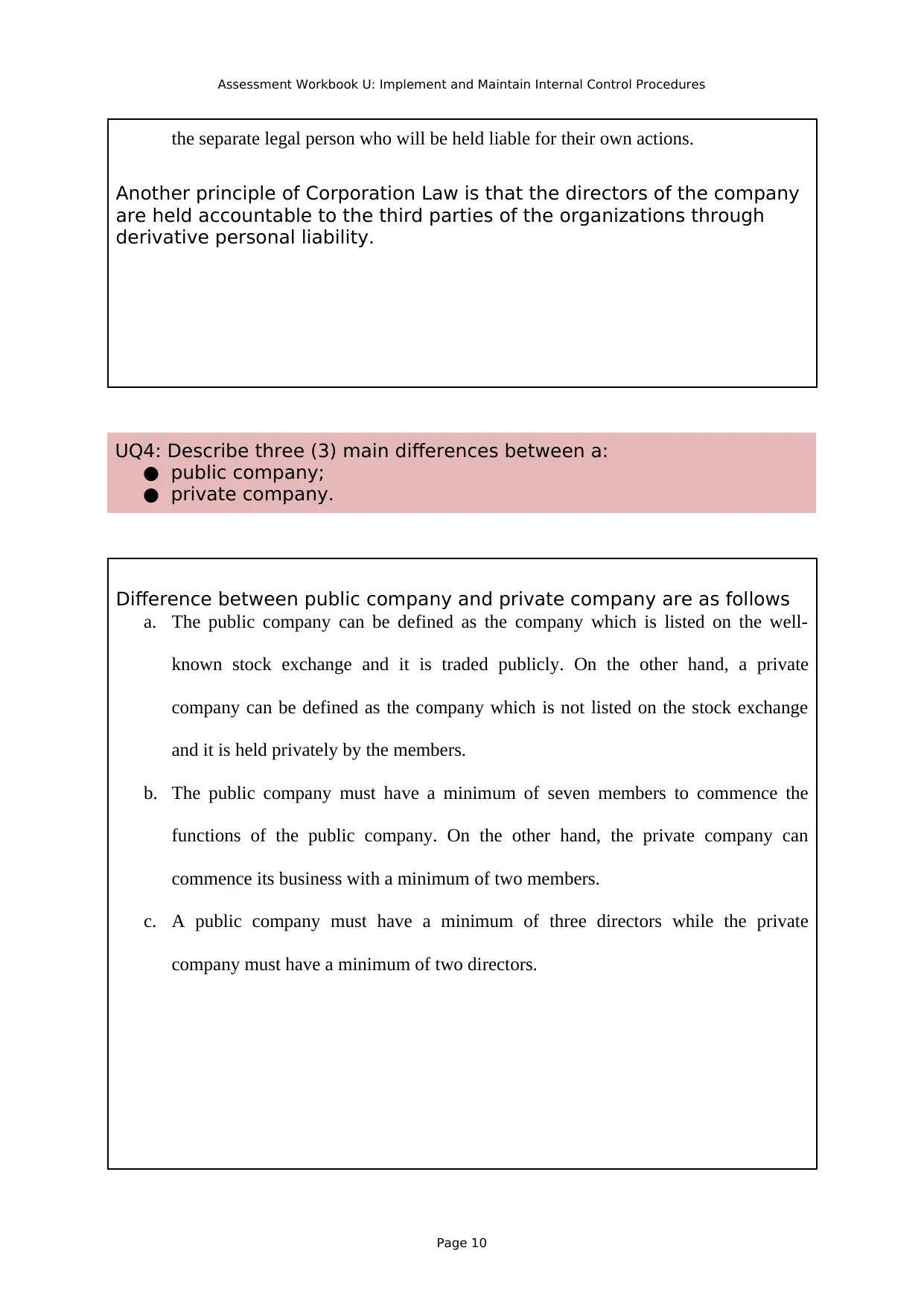
Assessment Workbook U: Implement and Maintain Internal Control Procedures
the separate legal person who will be held liable for their own actions.
Another principle of Corporation Law is that the directors of the company
are held accountable to the third parties of the organizations through
derivative personal liability.
UQ4: Describe three (3) main differences between a:
● public company;
● private company.
Difference between public company and private company are as follows
a. The public company can be defined as the company which is listed on the well-
known stock exchange and it is traded publicly. On the other hand, a private
company can be defined as the company which is not listed on the stock exchange
and it is held privately by the members.
b. The public company must have a minimum of seven members to commence the
functions of the public company. On the other hand, the private company can
commence its business with a minimum of two members.
c. A public company must have a minimum of three directors while the private
company must have a minimum of two directors.
Page 10
the separate legal person who will be held liable for their own actions.
Another principle of Corporation Law is that the directors of the company
are held accountable to the third parties of the organizations through
derivative personal liability.
UQ4: Describe three (3) main differences between a:
● public company;
● private company.
Difference between public company and private company are as follows
a. The public company can be defined as the company which is listed on the well-
known stock exchange and it is traded publicly. On the other hand, a private
company can be defined as the company which is not listed on the stock exchange
and it is held privately by the members.
b. The public company must have a minimum of seven members to commence the
functions of the public company. On the other hand, the private company can
commence its business with a minimum of two members.
c. A public company must have a minimum of three directors while the private
company must have a minimum of two directors.
Page 10
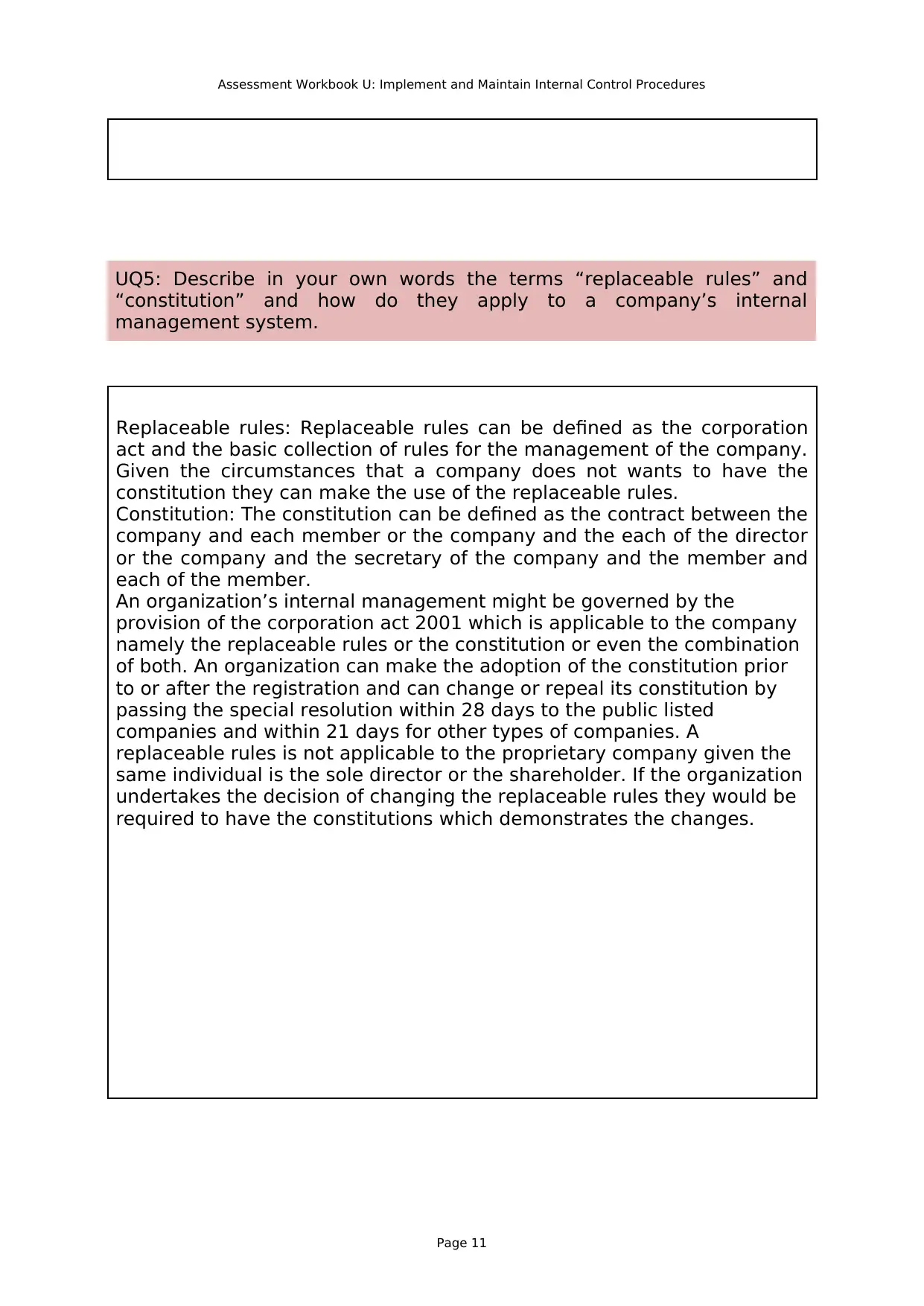
Assessment Workbook U: Implement and Maintain Internal Control Procedures
UQ5: Describe in your own words the terms “replaceable rules” and
“constitution” and how do they apply to a company’s internal
management system.
Replaceable rules: Replaceable rules can be defined as the corporation
act and the basic collection of rules for the management of the company.
Given the circumstances that a company does not wants to have the
constitution they can make the use of the replaceable rules.
Constitution: The constitution can be defined as the contract between the
company and each member or the company and the each of the director
or the company and the secretary of the company and the member and
each of the member.
An organization’s internal management might be governed by the
provision of the corporation act 2001 which is applicable to the company
namely the replaceable rules or the constitution or even the combination
of both. An organization can make the adoption of the constitution prior
to or after the registration and can change or repeal its constitution by
passing the special resolution within 28 days to the public listed
companies and within 21 days for other types of companies. A
replaceable rules is not applicable to the proprietary company given the
same individual is the sole director or the shareholder. If the organization
undertakes the decision of changing the replaceable rules they would be
required to have the constitutions which demonstrates the changes.
Page 11
UQ5: Describe in your own words the terms “replaceable rules” and
“constitution” and how do they apply to a company’s internal
management system.
Replaceable rules: Replaceable rules can be defined as the corporation
act and the basic collection of rules for the management of the company.
Given the circumstances that a company does not wants to have the
constitution they can make the use of the replaceable rules.
Constitution: The constitution can be defined as the contract between the
company and each member or the company and the each of the director
or the company and the secretary of the company and the member and
each of the member.
An organization’s internal management might be governed by the
provision of the corporation act 2001 which is applicable to the company
namely the replaceable rules or the constitution or even the combination
of both. An organization can make the adoption of the constitution prior
to or after the registration and can change or repeal its constitution by
passing the special resolution within 28 days to the public listed
companies and within 21 days for other types of companies. A
replaceable rules is not applicable to the proprietary company given the
same individual is the sole director or the shareholder. If the organization
undertakes the decision of changing the replaceable rules they would be
required to have the constitutions which demonstrates the changes.
Page 11
⊘ This is a preview!⊘
Do you want full access?
Subscribe today to unlock all pages.

Trusted by 1+ million students worldwide
1 out of 47
Related Documents
Your All-in-One AI-Powered Toolkit for Academic Success.
+13062052269
info@desklib.com
Available 24*7 on WhatsApp / Email
![[object Object]](/_next/static/media/star-bottom.7253800d.svg)
Unlock your academic potential
Copyright © 2020–2025 A2Z Services. All Rights Reserved. Developed and managed by ZUCOL.





